| |
Kidney Disease in Patients with HIV Infection and AIDS
|
| |
| |
Clinical Infectious Diseases Dec 1 2008;47:1449-1457
Jonathan Winston,1 Gilbert Deray,5 Trevor Hawkins,2 Lynda Szczech,3 Christina Wyatt,1 and Benjamin Young4
1Mount Sinai School of Medicine, New York, New York; 2University of New Mexico, Southwest CARE Center, Santa Fe; 3Duke University Medical Center, Durham, North Carolina; 4Rose Medical Center, Division of General Internal Medicine, University of Colorado at Denver and Health Sciences Center, Denver; and 5Department of Nephrology, Pitie-Salpetriere Hospital, Paris, France
"The aging of an HIV-infected population is another important pathway by which the incidence of CKD can be expected to continue to increase. GFR normally decreases with age. The prevalence of CKD in the elderly population now approaches 50% [21]. Other risk factors for CKD in HIV-infected patients are high viral load, low CD4+ lymphocyte count, and hepatitis C virus coinfection [17]. The importance of recognizing CKD is underscored by the strong correlation between CKD and both morbidity and mortality. In the HIV Epidemiology Research Study, proteinuria or an elevated serum creatinine level was associated with an increased risk of hospitalization and mortality [22, 23]. In the Women's Interagency HIV Study, elevated creatinine level and proteinuria were similarly predictive of an increased risk of an AIDS-defining illness and mortality [24].-
Diabetes mellitus and hypertension are the 2 most frequent causes of CKD in the general population. They increase the CKD risk 10-fold and account for 71% of all ESRD cases [3, 9]. Diabetes and hypertension are increasingly common among persons with HIV infection. The prevalence of diabetes was 14% in the Multicenter AIDS Cohort Study, 4-fold higher than in seronegative control persons [10], and was associated with cumulative exposure to nucleoside reverse-transcriptase inhibitors but not protease inhibitors (PIs) [11, 12]. Among those included in the Multicenter AIDS Cohort Study, the prevalence of hypertension is 3-fold higher than in age- and sex-matched control persons (34.2% vs. 11.9%; ), and hypertensive persons with HIV infection are more likely to have insulin resistance and metabolic syndrome (64..3% vs. 16.9%; ) [13]. In a cross-sectional analysis of 129 HIV-infected patients with CKD, the prevalence of documented hypertension and the prevalence of diabetes mellitus were 55% and 20%, respectively [14], which underscores the importance of optimizing blood pressure and achieving glycemic control as a means of minimizing the impact of CKD concomitant with HIV infection.
Race is an important risk factor for CKD. Young, male blacks have an 11-fold increased risk of CKD, compared with their white counterparts [15]. Five new cases of ESRD develop for every 100 cases of CKD in black persons, whereas only 1 new ESRD case develops for every 100 cases of CKD in whites
Glycemic control is critically important in delaying the progression of diabetic nephropathy. The American Diabetes Association recommends that adults with diabetes strive to maintain a glycated hemoglobin A1C level of <7.0%, preprandial plasma glucose level of 90-130 mg/dL (5.0-7.2 mmol/L), and peak postprandial plasma glucose level of <180 mg/dL (<10.0 mmol/L). Components of a successful glycemic control plan include blood glucose self-monitoring, hemoglobin A1C testing at least 2 times each year for patients who meet treatment goals and quarterly for patients who have not met their goals, and individualized medical nutrition therapy.
Kidney disease tends to be asymptomatic and is usually not the primary focus of a visit to an HIV clinic [28]. The presence of kidney disease should be anticipated, and screening and proper interpretation of the relationship between serum creatinine level and GFR are recommended. Just as optimal control of HIV replication is achievable for most patients, so too is control of hypertension and diabetes. The future holds enormous opportunities for research in new markers for early detection of kidney disease, prevention strategies, novel therapeutics, and a better understanding of the interaction between black race and kidney disease.
Ten percent of patients in a large ambulatory clinic experienced at least 1 episode of ARF (acute renal failure) over a 2-year period [25]. More than one-half of these episodes were attributed to underlying infections, 76% of which were AIDS-defining illnesses, and almost three-quarters of them necessitated hospitalization. Drug-related complications accounted for nearly one-third of cases-the conventional nephrotoxin amphotericin was most common-and liver disease accounted for 10% of cases. In an analysis of administrative data from >2 million hospital discharges in New York State, HIV infection was associated with a 2.8-fold increase in documented ARF cases [26]. In-hospital mortality was increased nearly 6-fold among HIV-infected patients with documented ARF."
As patients infected with human immunodeficiency virus (HIV) live longer while receiving antiretroviral therapy, kidney diseases have emerged as significant causes of morbidity and mortality. Black race, older age, hypertension, diabetes, low CD4+ cell count, and high viral load remain important risk factors for kidney disease in this population. Chronic kidney disease should be diagnosed in its early stages through routine screening and careful attention to changes in glomerular filtration rate or creatinine clearance. Hypertension and diabetes must be aggressively treated. Antiretroviral regimens themselves have been implicated in acute or chronic kidney disease. The risk of kidney disease associated with the widely used agent tenofovir continues to be studied, although its incidence in reported clinical trials and observational studies remains quite low. Future studies about the relationship between black race and kidney disease, as well as strategies for early detection and intervention of kidney disease, hold promise for meaningful reductions in morbidity and mortality associated with kidney disease.
Received 28 January 2008; accepted 13 August 2008; electronically published 23 October 2008.
Reprints or correspondence: Dr. Jonathan Winston, Mount Sinai School of Medicine, One Gustave L. Levy Pl., Box 1243, New York, NY 10029 (jonathan.winston@mssm.edu).
Historical Perspective
The first reports of AIDS-related renal failure, published in the mid-1980s, described cases of what we now recognize as HIV-associated nephropathy (HIVAN) [1]. Before effective antiviral therapy became available, HIVAN was so frequent and its clinical features were so dramatic-heavy proteinuria and rapid progression to end-stage renal disease (ESRD) in immunosuppressed black persons-that HIVAN became almost synonymous with HIV-associated chronic kidney disease (CKD). As HIV spread through the black community, the ESRD incidence increased substantially, and by the early 1990s, HIVAN became the third leading cause of ESRD in black persons aged 20-64 years [2].
Since that time, the incidence and spectrum of kidney diseases in HIV-infected patients have been altered by the widespread use of HAART. The clinical course of kidney disease is more indolent, the risk of ESRD has been reduced by 40%-60%, the 1-year survival rate while undergoing dialysis has increased from 25% to 75%, and kidney transplantation is a viable option [3-6]. Despite these improvements, risk factors for kidney disease are highly prevalent among HIV-infected patients, and kidney disease remains a significant cause of morbidity and mortality, even among those patients receiving HAART.
Epidemiology and Risk Factors for CKD in HIV-Infected Patients
CKD is defined as kidney damage or reduced kidney function that persists for >3 months [7]. A useful indicator of kidney damage is elevated urinary protein excretion, measured qualitatively with use of a urine dipstick or measured quantitatively with use of a spot urine protein-to-creatinine ratio (or 24-h urine collection). Kidney function can be reliably estimated from the serum creatinine by calculating the creatinine clearance or glomerular filtration rate (GFR) through use of the Cockcroft-Gault or Modification of Diet in Renal Disease (MDRD) equations, respectively. A GFR <60 mL/min meets criteria for CKD, a cutoff supported by epidemiologic data linking lower GFR to an increased frequency of hospitalization, cardiovascular events, or death. Neither the Cockcroft-Gault nor the MDRD equations has been specifically validated in the HIV-infected population. The MDRD equation was derived from patients with low GFR and therefore can yield variable results in persons with normal renal function [8]. Nonetheless, these estimates remain the most highly validated formulas available, and both equations are more sensitive than measurement of serum creatinine alone.
Diabetes mellitus and hypertension are the 2 most frequent causes of CKD in the general population. They increase the CKD risk 10-fold and account for 71% of all ESRD cases [3, 9]. Diabetes and hypertension are increasingly common among persons with HIV infection. The prevalence of diabetes was 14% in the Multicenter AIDS Cohort Study, 4-fold higher than in seronegative control persons [10], and was associated with cumulative exposure to nucleoside reverse-transcriptase inhibitors but not protease inhibitors (PIs) [11, 12]. Among those included in the Multicenter AIDS Cohort Study, the prevalence of hypertension is 3-fold higher than in age- and sex-matched control persons (34.2% vs. 11.9%; p<.001), and hypertensive persons with HIV infection are more likely to have insulin resistance and metabolic syndrome (64.3% vs. 16.9%; p<.001) [13]. In a cross-sectional analysis of 129 HIV-infected patients with CKD, the prevalence of documented hypertension and the prevalence of diabetes mellitus were 55% and 20%, respectively [14], which underscores the importance of optimizing blood pressure and achieving glycemic control as a means of minimizing the impact of CKD concomitant with HIV infection.
Race is an important risk factor for CKD. Black persons comprise 10% of the general population in the United States but account for >30% of patients with ESRD [3]. Young, male blacks have an 11-fold increased risk of CKD, compared with their white counterparts [15]. Five new cases of ESRD develop for every 100 cases of CKD in black persons, whereas only 1 new ESRD case develops for every 100 cases of CKD in whites [16]. The burden of kidney disease in black persons with HIV infection, compared with their HIV-infected white counterparts, is similarly disproportionate. Among persons with HIV infection who receive dialysis, 91% are black [3]. Black race increases the risk of microalbuminuria and proteinuria by at least 2-fold [17, 18]. In a comparison between blacks and whites in an analysis of >2 million patients who received care through the Veterans Administration system, the multivariate hazard ratio for ESRD in HIV-infected persons was 4.56 (95% CI, 3.44-6.05) [19]. The natural history of CKD is also considerably more aggressive in HIV-infected blacks than in whites. Among 4259 patients observed in the Johns Hopkins HIV Clinical Cohort from 1990 through 2004, the risk for incident CKD was 2-fold higher among blacks (hazard ratio 1.9; 95% CI, 1.2-2.8). After CKD diagnosis, however, the decrease in GFR was 6-fold more rapid among blacks, which dramatically increased the likelihood of progression to ESRD (hazard ratio, 17.7; 95% CI, 2.5-127) [20].
The aging of an HIV-infected population is another important pathway by which the incidence of CKD can be expected to continue to increase. GFR normally decreases with age. The prevalence of CKD in the elderly population now approaches 50% [21]. Other risk factors for CKD in HIV-infected patients are high viral load, low CD4+ lymphocyte count, and hepatitis C virus coinfection [17]. The importance of recognizing CKD is underscored by the strong correlation between CKD and both morbidity and mortality. In the HIV Epidemiology Research Study, proteinuria or an elevated serum creatinine level was associated with an increased risk of hospitalization and mortality [22, 23]. In the Women's Interagency HIV Study, elevated creatinine level and proteinuria were similarly predictive of an increased risk of an AIDS-defining illness and mortality [24].
Acute renal failure (ARF) in HIV-infected persons.
ARF is highly prevalent among persons with HIV infection and, like CKD, is linked to morbidity and mortality. Major risk factors are the same as in the general population, including older age, preexisting CKD, serious systemic illness or infection, and exposure to nephrotoxic agents [25, 26]. Liver disease and low CD4+ cell count also increase the risk of ARF among HIV-infected persons. Table 1 lists antivirals and antibiotics with nephrotoxic potential that are commonly used in treatment of HIV-infected patients.
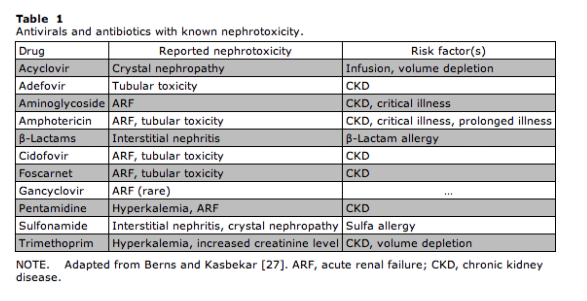
Ten percent of patients in a large ambulatory clinic experienced at least 1 episode of ARF over a 2-year period [25]. More than one-half of these episodes were attributed to underlying infections, 76% of which were AIDS-defining illnesses, and almost three-quarters of them necessitated hospitalization. Drug-related complications accounted for nearly one-third of cases-the conventional nephrotoxin amphotericin was most common-and liver disease accounted for 10% of cases. In an analysis of administrative data from >2 million hospital discharges in New York State, HIV infection was associated with a 2.8-fold increase in documented ARF cases [26]. In-hospital mortality was increased nearly 6-fold among HIV-infected patients with documented ARF.
Impact of Antiretroviral Therapy (ART) on Renal Function
Proper selection and dose-adjustment of antiretrovirals and other commonly used drugs for patients with kidney disease are important components of care for patients with HIV infection. Tables 2 and 3 summarize the nephrotoxic potential of antiretroviral agents and their recommended dose adjustments for those with kidney disease. Isolated case reports of nephrotoxicity have been reported with almost all agents, but renal disease has been associated with indinavir and tenofovir more often than with other drugs [27, 28].
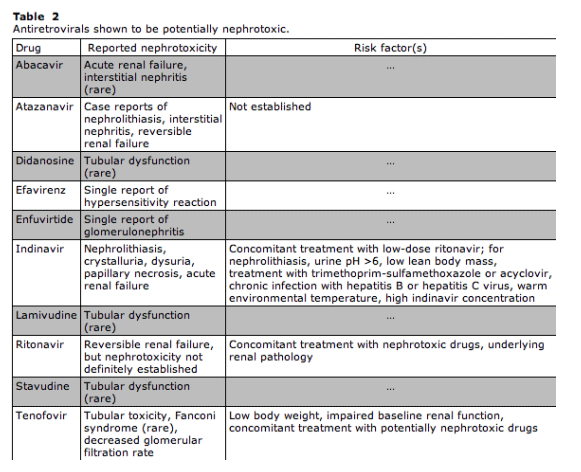
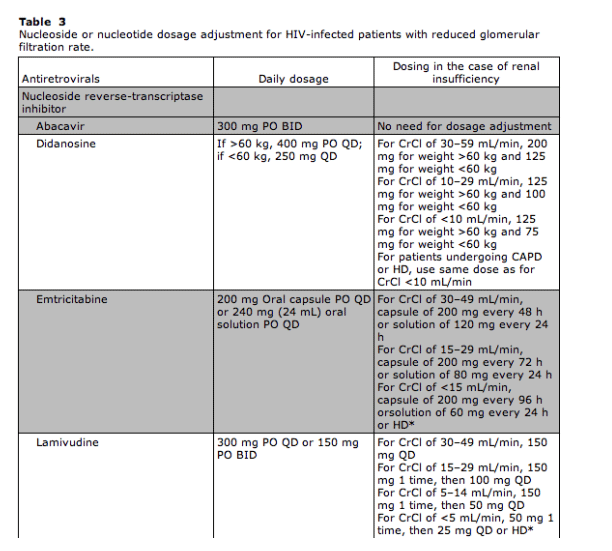
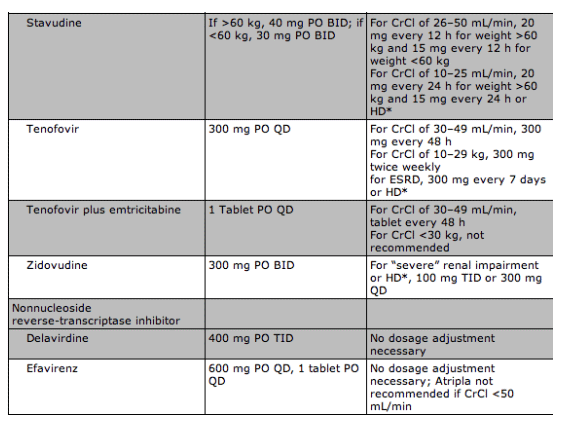
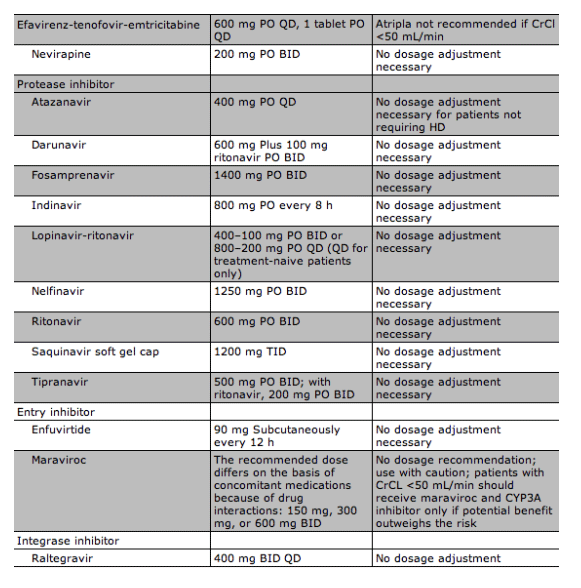
NOTE.Adapted from US Department of Health and Human Services guidelines for the use of antiretroviral agents in HIV-1-infected adults and adolescents [61]. Atripla, efavirenz-emtricitabine-tenofovir; BID, twice per day; CAPD, continuous ambulatory peritoneal dialysis; CrCL, creatinine clearance level; ESRD, end-stage renal disease; HD, hemodialysis; HD*, dose after HD; PO, orally; QD, every day; TID, 3 times per day.
Indinavir causes nephrolithiasis and chronic interstitial nephritis in as many as 12% of patients who receive it. The mainstay of prevention of this condition is adequate hydration, with intake of at least 1.5 L of noncaffeinated fluid. One report described 4 cases of renal colic and nephrolithiasis in patients who received lopinavir-ritonavir treatment, but a causal effect was not established [29]. Three cases of kidney stones containing atazanavir have been reported, and a review of the US Food and Drug Administration adverse event reporting system detected 12 additional confirmed cases [30-33]. Most cases required hospitalization for pain relief and stent insertion, percutaneous nephrostomy, lithotripsy, or endoscopic surgical extraction. Predisposing factors are unknown, and the drug was discontinued in most but not all cases.
The association of tenofovir with kidney disease has been an area of interest since the drug underwent preclinical testing, because of its structural similarity to adefovir and cidovir. These acyclic nucleotide analogues are excreted by renal tubule cell uptake and secretion [34]. Cidofovir at therapeutic doses can cause ARF, and a high incidence of ARF was noted when adefovir was tested for treatment of HIV-1 infection at dosages of 120 mg per day, which is 10-fold higher than the dosage for treating hepatitis B virus infection. Both agents induce proximal renal tubule cell damage, clinically characterized by phosphaturia, a modest amount of proteinuria ("tubule" proteinuria), and increases in serum creatinine [35, 36]. Consequently, considerable attention has been paid to the incidence of ARF or long-term reductions in GFR that are induced by tenofovir, with use of data from phase II, III, and IV clinical trials; expanded access programs before drug approval; and observational cohort studies. Case reports of tenofovir-induced ARF do exist, sometimes associated with proteinuria, hypohosphatemia, euglycemic glycosuria, hypouricemia, hypokalemia, or metabolic acidosis. This is known as Fanconi syndrome when most or all components are present.
In fact, tenofovir-associated renal dysfunction is a rare event in prospective clinical trials, particularly among ART-naive patients. No significant change in GFR was demonstrated in a comparison of tenofovir versus stavudine in combination with lamivudine-efavirenz [37] or in a comparison of tenofovir-emtricitabine versus fixed-dose zidovudine-lamivudine with efavirenz in ART-naive patients during 144 weeks of treatment [38]. Adverse renal events did not develop in a subgroup analysis of blacks in these 2 trials [39]. In the Development of Antiviral Therapy trial, which exclusively comprised patients from Uganda and Zimbabwe, 2469 (74%) of the 3316 enrolled patients received first-line ART with tenofovir and zidovudine-lamivudine. The overall incidence of severe reduction in GFR was low (1.6%), and no difference in renal safety endpoints was detected between the regimens [40].
Decreases in GFR in tenofovir-treated patients have been reported. In the Johns Hopkins Cohort, GFR decreased to a greater extent in tenofovir-treated patients than in non-tenfovir-treated patients (19 vs. 11 mL/min), an effect restricted to treatment-experienced patients [41]. Treatment-experienced patients could be more sensitive to adverse effects of tenofovir, more likely to experience adverse drug interactions, or more likely to develop kidney disease because of advanced HIV disease and its attendant comorbidities. The HIV Outpatient Study compared the renal outcomes of 593 tenofovir-treated subjects and 521 HAART-treated subjects who did not receive tenofovir. Tenofovir was associated with a small but statistically significant decrease in GFR, but only 1.1% of tenofovir-treated patients discontinued the drug because of adverse renal events [42].
Area under the curve for tenofovir is increased when it is combined with ritonavir-boosted PIs. One explanation has been that boosted PIs increase tenofovir's nephrotoxic potential by competing for the same renal transporters, thus impairing its tubule secretion, but recent studies do not support such a mechanism [43]. In 1 study involving about 140 subjects, a tenofovir-boosted PI regimen was associated with a 7-10 mL/min greater decrease in GFR over 48 weeks, compared with a tenofovir-nonnucleoside reverse-transcriptase inhibitor or non-tenofovir-containing regimen [44]. A higher proportion of tenofovir-treated patients in that report were treatment experienced, which perhaps contributed to those observations. In another study, 53 patients treated with tenofovir and boosted atazanavir after multiple prior treatment failures experienced a 7.8 mL/min decrease in GFR over 48 weeks [45], but control individuals were not studied. In an observational study of 445 tenofovir-treated patients observed for a mean of 13 months, GFR decreased a mean of 7 mL/min, and 2% of patients experienced a decrease in GFR to <60 mL/min. Concurrent use of didanosine or amprenavir increased the risk of a decrease in GFR [46]. Again, the change in GFR in non-tenofovir-containing regimens was not reported.
Several reports support the renal safety of tenofovir-boosted PI regimens. When tenofovir was coadministered with either atazanavir-ritonavir or lopinavir-ritonavir in heavily treatment-experienced patients, the rate of drug discontinuation attributable to renal disease was 1.3% [47]. A similar rate of drug discontinuation (1%-2%) was observed when lopinavir (800 mg) plus ritonavir (200 mg) once per day was compared with 400 mg/100 mg twice per day and when fosamprenavir-ritonavir was compared with atazanavir-ritonavir, all in combination with tenofovir-emtricitabine [48, 49]. In the CASTLE Study-which compared atazanavir-ritonavir at 300 mg/100 mg once per day with lopinavir-ritonavir at 400 mg/100 mg twice per day, both with fixed-dose tenofovir-emtricitabine-the rate of adverse event-related drug discontinuations was low (2% and 3%, respectively) [50]. The impact of a potential interaction between boosted PIs and tenofovir was specifically analyzed in the HIV Outpatient Study cohort by comparing renal function in 300 tenofovir-treated patients who received either nonnucleoside reverse-transcriptase inhibitors or boosted PIs (atazanavir or lopinavir). The 12-month intrapatient change in rate of creatinine clearance was not different between groups [51].
Data on the safety of tenofovir among patients with CKD is very limited. A small historical case series of 13 persons with CKD (median creatinine level, 1.7 mg/dL; median creatinine clearance, 56 mL/min; median GFR, 49 mL/min/1.73 m2) who received tenofovir for a median of 13 months showed a confirmed increase in National Kidney Foundation stage in 2 persons [52]. Eleven of 13 patients received an inappropriately high daily dosage of tenofovir, but limited median 12-month changes in creatinine clearance level or GFR were observed (+2.9 mL/min and +3.7 mL/min/1.73m2, respectively). Several patients had significant improvement in measured renal function.
All of these data show low absolute rates of drug discontinuation caused by renal dysfunction (0%-2%) or no differences in severe renal adverse events when tenofovir-containing regimens are compared with regimens not containing tenofovir [53-55]. GFR can decrease 7-10 mL/min over the course of 1 year in tenofovir-treated patients, but in most studies, the increase in serum creatinine level was too small to be identified as clinically significant (about 0.05 mg/dL), GFR remained in the normal range, and the rate of drug discontinuation was not greater for patients who received tenofovir. If the decrease in GFR were to continue for many years, it would have serious clinical implications, but no such trend has been reported. These data underscore the importance of carefully screening patients for preexisting renal disease, of following recommendations for appropriate dosage adjustments in patients with renal impairment, and of closely monitoring patients for changes in renal function. From the renal safety perspective, it would be prudent to seek an alternative and equally effective agent for patients who initiate ART with impaired kidney function (GFR, <60 mL/min), although other safety issues must also be considered.
Treating HIV-Infected Patients with CKD
Kidney function should be assessed according to existing Infectious Diseases Society of America guidelines [28]. All patients should have a screening urinalysis and a calculated estimate of GFR. Those at high risk for kidney disease (i.e., those with black race, CD4+ count <200 cells/mm3, HIV RNA levels >4000 copies/mL, diabetes, hypertension, or coinfection) should be screened annually to detect subtle changes over time. The standard urinary dipstick is a sufficient screen for proteinuria, but diabetic patients must be tested for microalbuminuria, defined as urinary albumin excretion of 30-300 μg/mg creatinine, a range not detected using conventional dipsticks [56]. Microalbuminuria in diabetic patients predicts subsequent decreases in GFR, and treatment with angiotensin-converting enzyme inhibitors or angiotensin-receptor blockers is indicated [57]. Microalbuminuria in nondiabetic patients has been linked to future cardiovascular events [58], a risk that may be modified by angiotensin-converting enzyme inhibitors or angiotensin-receptor blockers [59]. Several issues warrant further study when considering routine testing for microalbuminuria in nondiabetic patients with HIV infection: the reproducibility of the measurements, their proper timing (before or after initiation of ART), and proven benefits of long-term treatment with angiotensin-converting enzyme inhibitors or receptor blockers.
The general approach to diagnosing the cause of kidney disease is to seek reversible causes. Information obtained through the patient history and physical examination should be supplemented by a urinalysis to quantify protein excretion and to test for urinary cells and casts, as well as a renal sonogram to assess kidney size and structure. Additional testing should be individualized (figure 1). A kidney biopsy should be strongly considered for patients with unexplained kidney disease, especially those with heavy proteinuria or reduced GFR, because they are at the greatest risk of ESRD. It is difficult to predict which disease may be affecting the kidneys on clinical grounds alone, although in 1 center, HIVAN was considerably more common when viral load was >400 copies/mL, whereas diseases such as hypertension, diabetes, or classic focal segmental glomerulosclerosis were more common when viral load was <400 copies/mL [60]. A special circumstance for a kidney biopsy exists when seeking the diagnosis of HIVAN in a HAART-naive patient with kidney disease, particularly when ART would not otherwise be warranted because of a CD4+ T cell count >350 cells/mm3. Ongoing viral replication is directly responsible for the renal disease in HIVAN, and ART is recommended, irrespective of CD4+ T cell count, because it preserves kidney function and improves survival [5, 61, 62].
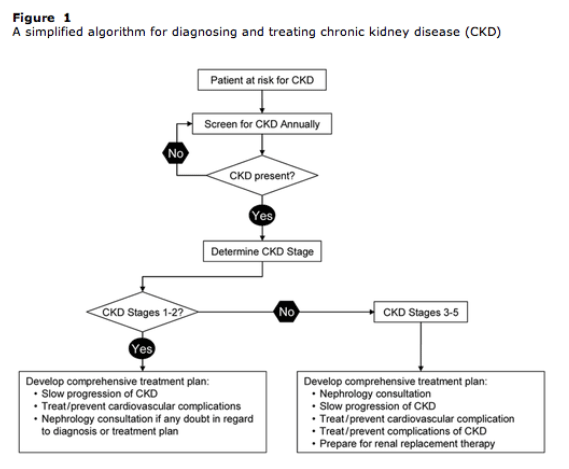
For most patients, the most effective approach to CKD treatment is effective medical management of diabetes and hypertension. Blood pressure should be monitored at each office visit, and antihypertensive treatment should be targeted to a blood pressure <130/80 mm Hg [63]. Angiotensin-converting enzyme inhibitors or angiotensin-receptor blockers are the drugs of first choice, because they reduce urinary protein excretion [57] and slow the progression to ESRD (figure 2). Beta-blockers or nondihydropyridine calcium channel blockers are alternatives, but their metabolism can be blocked by PIs. Most patients with hypertension and diabetes will require at least 2 antihypertensive medications to achieve optimal control of blood pressure [64].
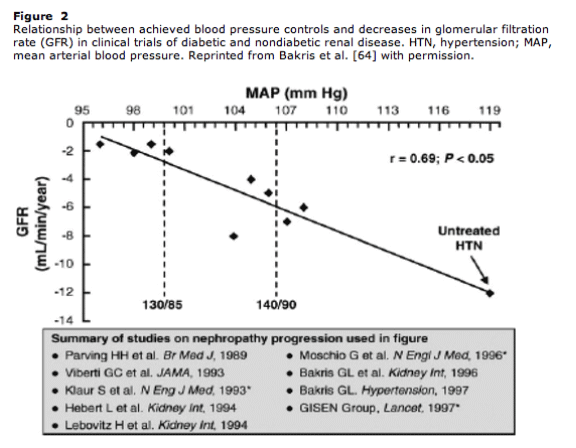
Glycemic control is critically important in delaying the progression of diabetic nephropathy. The American Diabetes Association recommends that adults with diabetes strive to maintain a glycated hemoglobin A1C level of <7.0%, preprandial plasma glucose level of 90-130 mg/dL (5.0-7.2 mmol/L), and peak postprandial plasma glucose level of <180 mg/dL (<10.0 mmol/L). Components of a successful glycemic control plan include blood glucose self-monitoring, hemoglobin A1C testing at least 2 times each year for patients who meet treatment goals and quarterly for patients who have not met their goals, and individualized medical nutrition therapy.
Kidney disease tends to be asymptomatic and is usually not the primary focus of a visit to an HIV clinic [28]. The presence of kidney disease should be anticipated, and screening and proper interpretation of the relationship between serum creatinine level and GFR are recommended. Just as optimal control of HIV replication is achievable for most patients, so too is control of hypertension and diabetes. The future holds enormous opportunities for research in new markers for early detection of kidney disease, prevention strategies, novel therapeutics, and a better understanding of the interaction between black race and kidney disease.
Acknowledgments
We acknowledge Healthmatters Communications for receiving payments from the commercial supporter for research and editorial assistance.
Financial support. This article is derived from a content-development meeting, Renal Considerations in HIV Management (2007). An independent educational grant for this program, including a Continuing Medical Education-certified Web cast, was provided by Gilead Sciences Medical Affairs.
Potential conflicts of interest. J.W. has received consulting and lecture fees from Gilead Sciences. T.H. has received consulting and/or speaker fees from Abbott, Bristol-Myers Squibb, GlaxoSmithKline, Gilead Sciences, Merck, Monogram Bioscience, Pfizer, and Tibotech. L.S. has received consulting fees from Ortho Biotech Clinical Affairs, Nabi Pharmaceuticals, Gilead, Fresenius Medical Care, Kureha, Affymax, and Acologix; lecture fees from Nabi Biopharmaceuticals, Fresenius Medical Care, GlaxoSmithKline, Gilead, Genzyme, Abbott, Amgen, and Ortho Biotech; and grant support from Ortho Biotech Clinical Affairs, GlaxoSmithKline, Pfizer, and Genzyme. C.W. has received grant support from the Gilead Foundation and lecture fees from Gilead Sciences and Roche. B.Y. has been a consultant to Bristol-Myers Squibb, Cerner Corporation, Gilead Sciences, GlaxoSmithKline, Hoffman-LaRoche, Merck, Monogram Bioscience, Pfizer, and Vertex Pharmaceuticals; has served on the speakers' bureau for GlaxoSmithKline, Merck, and Monogram Bioscience; and has received grant and/or research funding from Bristol-Myers Squibb, Cerner, Gilead Sciences, GlaxoSmithKline, Hoffman-LaRoche, and Merck. G.D.; no conflicts.
References
* 1.Rao TK, Filippone EJ, Nicastri AD, et al. Associated focal and segmental glomerulosclerosis in the acquired immunodeficiency syndrome. N Engl J Med 1984;310:669-73.
* 2.Winston JA, Klotman PE. Are we missing an epidemic of HIV-associated nephropathy? J Am Soc Nephrol 1996;7:1-7.
* 3.US Renal Data System. USRDS 2007 annual data report: atlas of chronic kidney disease and end-stage renal disease in the United States. Bethesda, MD: National Institutes of Health, National Institute of Diabetes and Digestive and Kidney Diseases, 2007.
* 4.Ahuja TS, Grady J, Khan S. Changing trends in the survival of dialysis patients with human immunodeficiency virus in the United States. J Am Soc Nephrol 2002;13:1889-93.
* 5.Schwartz EJ, Szczech LA, Ross MJ, Klotman ME, Winston JA, Klotman PE. Highly active antiretroviral therapy and the epidemic of HIV+ end-stage renal disease. J Am Soc Nephrol 2005;16:2412-20.
* 6.Lucas GM, Eustace JA, Sozio S, Mentari EK, Appiah KA, Moore RD. Highly active antiretroviral therapy and the incidence of HIV-1-associated nephropathy: a 12-year cohort study. AIDS 2004;18:541-6.
* 7.Coresh J, Astor BC, Greene T, Eknoyan G, Levey AS. Prevalence of chronic kidney disease and decreased kidney function in the adult US population: Third National Health and Nutrition Examination Survey. Am J Kidney Dis 2003;41:1-12.
* 8.Stevens LA, Coresh J, Feldman HI, et al. Evaluation of the modification of diet in renal disease study equation in a large diverse population. J Am Soc Nephrol 2007;18:2749-57.
* 9.Coresh J, Byrd-Holt D, Astor BC, et al. Chronic kidney disease awareness, prevalence, and trends among U.S. adults, 1999 to 2000. J Am Soc Nephrol 2005;16:180-8.
* 10.Brown TT, Cole SR, Li X, et al. Antiretroviral therapy and the prevalence and incidence of diabetes mellitus in the multicenter AIDS cohort study. Arch Intern Med 2005;165:1179-84.
* 11.Brown TT, Li X, Cole SR, et al. Cumulative exposure to nucleoside analogue reverse transcriptase inhibitors is associated with insulin resistance markers in the Multicenter AIDS Cohort Study. AIDS 2005;19:1375-83.
* 12.Tien PC, Schneider MF, Cole SR, et al. Antiretroviral therapy exposure and incidence of diabetes mellitus in the Women's Interagency HIV Study. AIDS 2007;21:1739-45.
* 13.Gazzaruso C, Bruno R, Garzaniti A, et al. Hypertension among HIV patients: prevalence and relationships to insulin resistance and metabolic syndrome. J Hypertens 2003;21:1377-82.
* 14.Wyatt CM, Winston JA, Malvestutto CD, et al. Chronic kidney disease in HIV infection: an urban epidemic. AIDS 2007;21:2101-3.
* 15.Stehman-Breen CO, Gillen D, Steffes M, et al. Racial differences in early-onset renal disease among young adults: the coronary artery risk development in young adults (CARDIA) study. J Am Soc Nephrol 2003;14:2352-7.
* 16.Hsu CY, Lin F, Vittinghoff E, Shlipak MG. Racial differences in the progression from chronic renal insufficiency to end-stage renal disease in the United States. J Am Soc Nephrol 2003;14:2902-7.
* 17.Szczech LA, Gange SJ, van der Horst C, et al. Predictors of proteinuria and renal failure among women with HIV infection. Kidney Int 2002;61:195-202.
* 18.Szczech LA, Grunfeld C, Scherzer R, et al. Microalbuminuria in HIV infection. AIDS 2007;21:1003-9.
* 19.Choi AI, Rodriguez RA, Bacchetti P, Bertenthal D, Volberding PA, O'Hare AM. Racial differences in end-stage renal disease rates in HIV infection versus diabetes. J Am Soc Nephrol 2007;18:2968-74.
* 20.Lucas GM, Lau B, Atta MG, Fine DM, Keruly J, Moore RD. Chronic kidney disease incidence, and progression to end-stage renal disease, in HIV-infected individuals: a tale of two races. J Infect Dis 2008;197:1548-57.
* 21.Coresh J, Selvin E, Stevens LA, et al. Prevalence of chronic kidney disease in the United States. JAMA 2007;298:2038-47.
* 22.Gardner LI, Holmberg SD, Williamson JM, et al. Development of proteinuria or elevated serum creatinine and mortality in HIV-infected women. J Acquir Immune Defic Syndr 2003;32:203-9.
* 23.Gardner LI, Klein RS, Szczech LA, et al. Rates and risk factors for condition-specific hospitalizations in HIV-infected and uninfected women. J Acquir Immune Defic Syndr 2003;34:320-30.
* 24.Szczech LA, Hoover DR, Feldman JG, et al. Association between renal disease and outcomes among HIV-infected women receiving or not receiving antiretroviral therapy. Clin Infect Dis 2004;39:1199-206.
* 25.Franceschini N, Napravnik S, Eron JJ Jr, Szczech LA, Finn WF. Incidence and etiology of acute renal failure among ambulatory HIV-infected patients. Kidney Int 2005;67:1526-31.
* 26.Wyatt CM, Arons RR, Klotman PE, Klotman ME. Acute renal failure in hospitalized patients with HIV: risk factors and impact on in-hospital mortality. AIDS 2006;20:561-5.
* 27.Berns JS, Kasbekar N. Highly active antiretroviral therapy and the kidney: an update on antiretroviral medications for nephrologists. Clin J Am Soc Nephrol 2006;1:117-29.
* 28.Gupta SK, Eustace JA, Winston JA, et al. Guidelines for the management of chronic kidney disease in HIV-infected patients: recommendations of the HIV Medicine Association of the Infectious Diseases Society of America. Clin Infect Dis 2005;40:1559-85.
* 29.Doco-Lecompte T, Garrec A, Thomas L, Trechot P, May T, Rabaud C. Lopinavir-ritonavir (Kaletra) and lithiasis: seven cases. AIDS 2004;18:705-6.
* 30.Chang HR, Pella PM. Atazanavir urolithiasis. N Engl J Med 2006;355:2158-9.
* 31.Pacanowski J, Poirier JM, Petit I, Meynard JL, Girard PM. Atazanavir urinary stones in an HIV-infected patient. AIDS 2006;20:2131.
* 32.Anderson PL, Lichtenstein KA, Gerig NE, Kiser JJ, Bushman L. Atazanavir-containing renal calculi in an HIV-infected patient. AIDS 2007;21:1060-2.
* 33.Chan-Tack KM, Truffa MM, Struble KA, Birnkrant DB. Atazanavir-associated nephrolithiasis: cases from the US Food and Drug Administration's Adverse Event Reporting System. AIDS 2007;21:1215-8.
* 34.Cihlar T, Ho ES, Lin DC, Mulato AS. Human renal organic anion transporter 1 (hOAT1) and its role in the nephrotoxicity of antiviral nucleotide analogs. Nucleosides Nucleotides Nucleic Acids 2001;20:641-8.
* 35.Kahn J, Lagakos S, Wulfsohn M, et al. Efficacy and safety of adefovir dipivoxil with antiretroviral therapy: a randomized controlled trial. JAMA 1999;282:2305-12.
* 36.Lalezari JP, Stagg RJ, Kuppermann BD, et al. Intravenous cidofovir for peripheral cytomegalovirus retinitis in patients with AIDS: a randomized, controlled trial. Ann Intern Med 1997;126:257-63.
* 37.Izzedine H, Hulot JS, Vittecoq D, et al. Long-term renal safety of tenofovir disoproxil fumarate in antiretroviral-naive HIV-1-infected patients: data from a double-blind randomized active-controlled multicentre study. Nephrol Dial Transplant 2005;20:743-6.
* 38.Arribas JR, Pozniak AL, Gallant JE, et al. Tenofovir disoproxil fumarate, emtricitabine, and efavirenz compared with zidovudine/lamivudine and efavirenz in treatment-naive patients: 144-week analysis. J Acquir Immune Defic Syndr 2008;47:74-8.
* 39.Gallant JE, Pozniak AL, Staszewski S, et al. Efficacy and safety of tenofovir DF (TDF)-containing vs non-TDF-containing regimens in black antiretroviral-naive patients [poster 505]. In: Program and abstracts of the 14th Conference Retroviruses and Opportunistic Infections (Los Angeles, CA). Alexandria, VA: Foundation for Retrovirology and Human Health, 2007.
* 40.Reid A, Stohr W, Walker AS, et al; for the Development of Antiretroviral Therapy Trial. Severe renal dysfunction and risk factors associated with renal impairment in HIV-infected adults in Africa initiating antiretroviral therapy. Clin Infect Dis 2008;46:1271-81.
* 41.Gallant JE, Parish MA, Keruly JC, Moore RD. Changes in renal function associated with tenofovir disoproxil fumarate treatment, compared with nucleoside reverse-transcriptase inhibitor treatment. Clin Infect Dis 2005;40:1194-8.
* 42.Young B, Buchacz K, Baker RK, et al. Renal function in tenofovir-exposed and tenofovir-unexposed patients receiving highly active antiretroviral therapy in the HIV Outpatient Study. J Int Assoc Physicians AIDS Care (Chic Ill) 2007;6:178-87.
* 43.Cihlar T, Ray AS, Laflamme G, et al. Molecular assessment of the potential for renal drug interactions between tenofovir and HIV protease inhibitors. Antivir Ther 2007;12:267-72.
* 44.Goicoechea M, Liu S, Best B, et al. Greater tenofovir-associated renal function decline with protease inhibitor-based versus nonnucleoside reverse-transcriptase inhibitor-based therapy. J Infect Dis 2008;197:102-8.
* 45.Gerard L, Chazallon C, Taburet AM, Girard PM, Aboulker JP, Piketty C. Renal function in antiretroviral-experienced patients treated with tenofovir disoproxil fumarate associated with atazanavir/ritonavir. Antivir Ther 2007;12:31-9.
* 46.Crane HM, Kestenbaum B, Harrington RD, Kitahata MM. Amprenavir and didanosine are associated with declining kidney function among patients receiving tenofovir. AIDS 2007;21:1431-9.
* 47.Johnson M, Grinsztejn B, Rodriguez C, et al. 96-Week comparison of once-daily atazanavir/ritonavir and twice-daily lopinavir/ritonavir in patients with multiple virologic failures. AIDS 2006;20:711-8.
* 48.Johnson MA, Gathe JC Jr, Podzamczer D, et al. A once-daily lopinavir/ritonavir-based regimen provides noninferior antiviral activity compared with a twice-daily regimen. J Acquir Immune Defic Syndr 2006;43:153-60.
* 49.Smith KY, Weinberg WG, DeJesus E, et al. Fosamprenavir or atazanavir once daily boosted with ritonavir 100 mg, plus tenofovir/emtricitabine, for the initial treatment of HIV infection: 48-week results of ALERT. ALERT (COL103952) Study Team. AIDS Res Ther 2008;5:5.
* 50.Molina JM, Andrade-Villanueva J, Echevarria J, et al. Once-daily atazanavir/ritonavir versus twice-daily lopinavir/ritonavir, each in combination with tenofovir and emtricitabine, for management of antiretroviral-naive HIV-1-infected patients: 48 week efficacy and safety results of the CASTLE study. 2008;372:646-55.
* 51.Buchacz K, Young B, Baker RK, et al. Renal function in patients receiving tenofovir with ritonavir/lopinavir or ritonavir/atazanavir in the HIV Outpatient Study (HOPS) cohort. J Acquir Immune Defic Syndr 2006;43:626-8.
* 52.Young B, Buchacz K, Moorman A, Wood KC, Brooks JT. Renal function in patients with pre-existing renal disease receiving tenofovir-containing HAART in the HIV Outpatient Study (HOPS) cohort. In: Program and abstracts of the 47th Annual Interscience Conference on Antimicrobial Agents and Chemotherapy, (Chicago, IL). Washington, DC: American Society for Microbiology, 2007.
* 53.Moreno S, Domingo P, Palacios R, et al. Renal safety of tenofovir disoproxil fumarate in HIV-1 treatment-experienced patients with adverse events related to prior NRTI use: data from a prospective, observational, multicenter study. J Acquir Immune Defic Syndr 2006;42:385-7.
* 54.Jones R, Stebbing J, Nelson M, et al. Renal dysfunction with tenofovir disoproxil fumarate-containing highly active antiretroviral therapy regimens is not observed more frequently: a cohort and case-control study. J Acquir Immune Defic Syndr 2004;37:1489-95.
* 55.Winston A, Amin J, Mallon P, et al. Minor changes in calculated creatinine clearance and anion-gap are associated with tenofovir disoproxil fumarate-containing highly active antiretroviral therapy. HIV Med 2006;7:105-11.
* 56.National Kidney Disease and Education Program. Quick reference on UACR and GFR. Available at: http://nkdep.nih.gov/resources/uacr-gfr-quickreference.htm. Accessed 3 December 2007.
* 57.Molitch ME, DeFronzo RA, Franz MJ, et al. Nephropathy in diabetes. Diabetes Care 2004;27(Suppl 1):S79-83.
* 58.Gerstein HC, Mann JF, Yi Q, et al. Albuminuria and risk of cardiovascular events, death, and heart failure in diabetic and nondiabetic individuals. JAMA 2001;286:421-6.
* 59.Arnold JM, Yusuf S, Young J, et al. Prevention of heart failure in patients in the Heart Outcomes Prevention Evaluation (HOPE) Study. Circulation 2003;107:1284-90.
* 60.Estrella M, Fine DM, Gallant JE, et al. HIV type 1 RNA level as a clinical indicator of renal pathology in HIV-infected patients. Clin Infect Dis 2006;43:377-80.
* 61.Panel on Antiretroviral Guidelines for Adult and Adolescents. Guidelines for the use of antiretroviral agents in HIV-1-infected adults and adolescents. Department of Health and Human Services. 29 January 2008;1-128. Available at http://www.aidsinfo.nih.gov/ContentFiles/AdultandAdolescentGL.pdf. Accessed 12 October 2008.
* 62.Atta MG, Gallant JE, Rahman MH, et al. Antiretroviral therapy in the treatment of HIV-associated nephropathy. Nephrol Dial Transplant 2006;21:2809-13.
* 63.Chobanian AV, Bakris GL, Black HR, et al. The seventh report of the Joint National Committee on prevention, detection, evaluation, and treatment of high blood pressure: the JNC 7 report. JAMA 2003;289:2560-72.
* 64.Bakris GL, Williams M, Dworkin L, et al. Preserving renal function in adults with hypertension and diabetes: a consensus approach. National Kidney Foundation Hypertension and Diabetes Executive Committees Working Group. Am J Kidney Dis 2000;36:646-61.
|
|
| |
| |
|
|
|